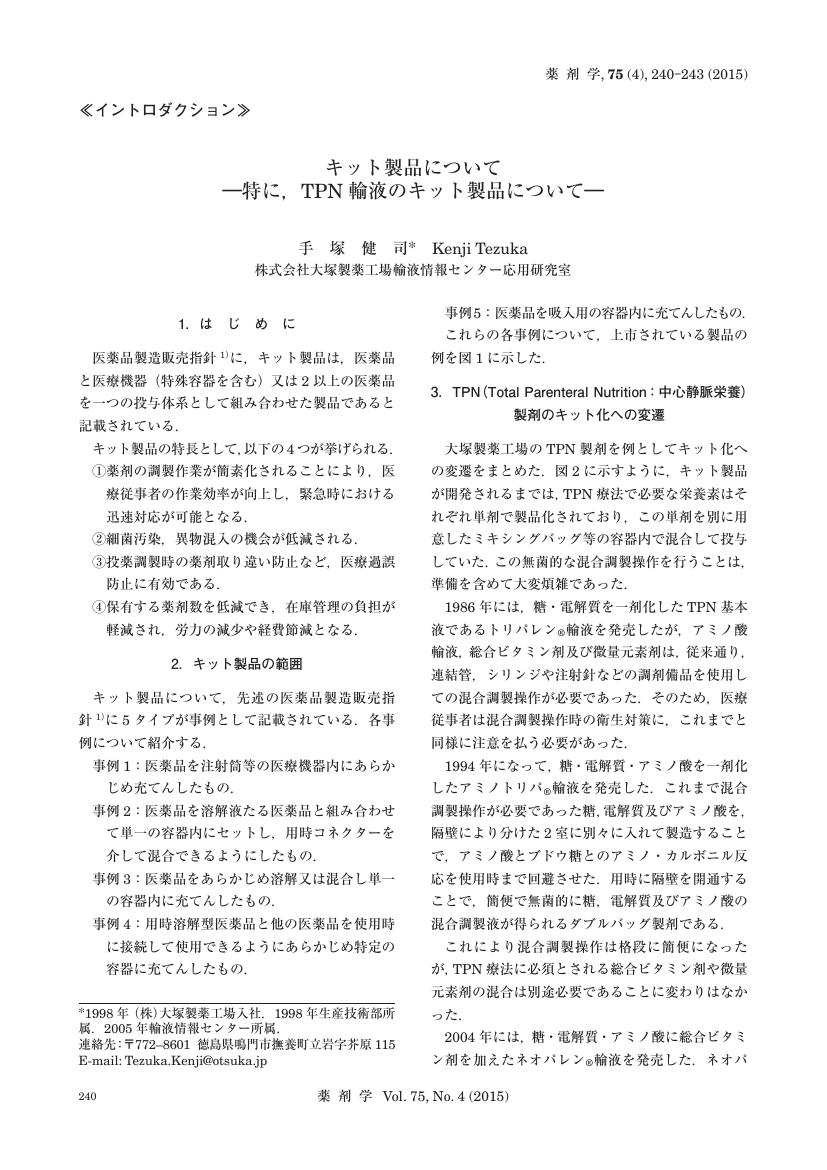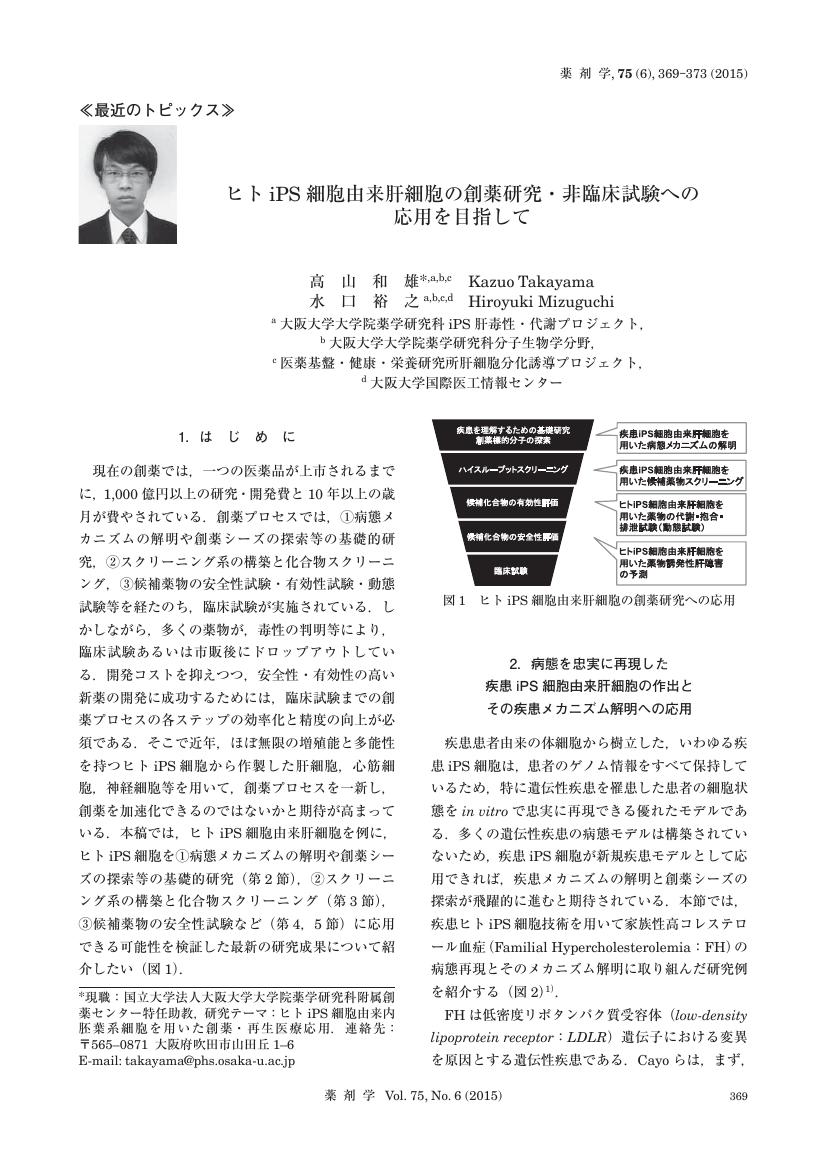1 0 0 0 OA 口腔内速溶フィルム製剤
- 著者
- 粟村 努
- 出版者
- 公益社団法人 日本薬剤学会
- 雑誌
- 薬剤学 (ISSN:03727629)
- 巻号頁・発行日
- vol.69, no.1, pp.40-46, 2009 (Released:2019-03-31)
- 参考文献数
- 10
1 0 0 0 OA ペプチド・タンパク性医薬品の経粘膜透過促進
- 著者
- 山本 昌
- 出版者
- 公益社団法人 日本薬剤学会
- 雑誌
- 薬剤学 (ISSN:03727629)
- 巻号頁・発行日
- vol.74, no.1, pp.19-26, 2014 (Released:2014-07-01)
- 参考文献数
- 10
1 0 0 0 OA 抗微生物薬のPK/PD解析に基づいた至適投与設計法の確立
- 著者
- 松元 一明
- 出版者
- 公益社団法人 日本薬剤学会
- 雑誌
- 薬剤学 (ISSN:03727629)
- 巻号頁・発行日
- vol.76, no.2, pp.87-91, 2016 (Released:2016-09-01)
- 参考文献数
- 5
1 0 0 0 OA 奇妙奇天烈 摩訶不思議 奇想天外
- 著者
- 並木 徳之
- 出版者
- 公益社団法人 日本薬剤学会
- 雑誌
- 薬剤学 (ISSN:03727629)
- 巻号頁・発行日
- vol.78, no.6, pp.245, 2018 (Released:2018-11-01)
1 0 0 0 OA 「革新的医薬品の現状と今後の展望」について
- 著者
- 加藤 くみ子 川上 亘作 松田 嘉弘
- 出版者
- 公益社団法人 日本薬剤学会
- 雑誌
- 薬剤学 (ISSN:03727629)
- 巻号頁・発行日
- vol.79, no.3, pp.108-112, 2019 (Released:2019-05-01)
1 0 0 0 OA 皮膚適用製剤用新規基剤の開発を目指して
- 著者
- 藤井 まき子
- 出版者
- 公益社団法人 日本薬剤学会
- 雑誌
- 薬剤学 (ISSN:03727629)
- 巻号頁・発行日
- vol.77, no.4, pp.197-200, 2017-07-01 (Released:2017-07-01)
- 参考文献数
- 5
1 0 0 0 OA 計算毒性学の基礎と毒性予測の現状
- 著者
- 植沢 芳広
- 出版者
- 公益社団法人 日本薬剤学会
- 雑誌
- 薬剤学 (ISSN:03727629)
- 巻号頁・発行日
- vol.77, no.5, pp.270-274, 2017-09-01 (Released:2017-09-01)
- 参考文献数
- 5
- 被引用文献数
- 1
1 0 0 0 OA 次世代の薬剤師に求められるもの
- 著者
- 伊東 明彦
- 出版者
- 公益社団法人 日本薬剤学会
- 雑誌
- 薬剤学 (ISSN:03727629)
- 巻号頁・発行日
- vol.76, no.4, pp.210-213, 2016-07-01 (Released:2017-01-01)
- 参考文献数
- 3
1 0 0 0 OA 薬学部・薬科大学新設ラッシュに思う
- 著者
- 井村 伸正
- 出版者
- 公益社団法人 日本薬剤学会
- 雑誌
- 薬剤学 (ISSN:03727629)
- 巻号頁・発行日
- vol.63, no.2, pp.49-50, 2003 (Released:2019-05-12)
1 0 0 0 特集「薬剤学と日本の未来のミライを考える」
- 著者
- 白坂 善之 柏倉 康治
- 出版者
- 公益社団法人 日本薬剤学会
- 雑誌
- 薬剤学 (ISSN:03727629)
- 巻号頁・発行日
- vol.79, no.1, pp.4-6, 2019
- 著者
- 福居 篤子
- 出版者
- 公益社団法人 日本薬剤学会
- 雑誌
- 薬剤学 = Journal of Pharmaceutical Science and Technology, Japan (ISSN:03727629)
- 巻号頁・発行日
- vol.64, no.4, pp.240-244, 2004-07-01
- 参考文献数
- 7
1 0 0 0 OA 6年制下の病院・薬局実務実習の問題点
- 著者
- 掛見 正郎
- 出版者
- 公益社団法人 日本薬剤学会
- 雑誌
- 薬剤学 (ISSN:03727629)
- 巻号頁・発行日
- vol.71, no.6, pp.305-308, 2011 (Released:2019-03-02)
1 0 0 0 OA 企業研究を志す若手研究者たちへのメッセージ
- 著者
- 肥後 成人
- 出版者
- 公益社団法人 日本薬剤学会
- 雑誌
- 薬剤学 (ISSN:03727629)
- 巻号頁・発行日
- vol.76, no.5, pp.291-293, 2016-09-01 (Released:2017-01-01)
- 参考文献数
- 2
1 0 0 0 OA キット製品について—特に,TPN輸液のキット製品について—
- 著者
- 手塚 健司
- 出版者
- 公益社団法人 日本薬剤学会
- 雑誌
- 薬剤学 (ISSN:03727629)
- 巻号頁・発行日
- vol.75, no.4, pp.240-243, 2015 (Released:2016-01-01)
- 参考文献数
- 1
- 著者
- 尾関 哲也
- 出版者
- 公益社団法人 日本薬剤学会
- 雑誌
- 薬剤学 (ISSN:03727629)
- 巻号頁・発行日
- vol.78, no.5, pp.235-236, 2018-09-01 (Released:2018-09-01)
- 参考文献数
- 4
1 0 0 0 OA 医療用緑内障点眼剤の開発変遷の分析
- 著者
- 中田 雄一郎
- 出版者
- 公益社団法人 日本薬剤学会
- 雑誌
- 薬剤学 (ISSN:03727629)
- 巻号頁・発行日
- vol.75, no.1, pp.65-71, 2015 (Released:2015-01-01)
- 参考文献数
- 10
From descriptions on the package inserts and interview forms accessible on the home page of the Pharmaceuticals and Medical Devices Agency (PMDA), the characteristics of active pharmaceutical ingredients, pharmaceutical production, and formulations of 106 glaucoma therapeutic agents currently used in clinical practice in Japan were analyzed. Since eye drops are a sterile preparation and are administered multiple times, their efficacy, safety, stability and preservation must be taken into consideration. The pH (4-8) and osmotic pressure (0.6-1.6) were well controlled within a fixed range and some additives were compounded in the eye drops for the purpose of making the users feel more comfortable. It was also found that there was a difference in the use of solubilizing agents and preservatives between domestic and global pharmaceutical companies. There has been no article to compare the eye drop formulations of glaucoma therapeutic agents for 45 years; therefore, this paper will help to show future directionality of the preparation development of eye drops.
- 著者
- 山西 芳裕
- 出版者
- 公益社団法人 日本薬剤学会
- 雑誌
- 薬剤学 (ISSN:03727629)
- 巻号頁・発行日
- vol.78, no.2, pp.77-81, 2018 (Released:2018-03-01)
- 参考文献数
- 5
1 0 0 0 OA miRNAによる薬の代謝・毒性制御
- 著者
- 中島 美紀
- 出版者
- 公益社団法人 日本薬剤学会
- 雑誌
- 薬剤学 (ISSN:03727629)
- 巻号頁・発行日
- vol.76, no.2, pp.99-104, 2016 (Released:2016-09-01)
- 参考文献数
- 5
1 0 0 0 ニューラルネットワークによる製剤処方の最適化
- 著者
- 高山 幸三 藤川 未来人 小幡 誉子 森下 真莉子 永井 恒司
- 出版者
- 公益社団法人 日本薬剤学会
- 雑誌
- 薬剤学 = Journal of Pharmaceutical Science and Technology, Japan (ISSN:03727629)
- 巻号頁・発行日
- vol.64, no.1, pp.2-12, 2004-01-01
- 参考文献数
- 71
- 被引用文献数
- 3
<p>A pharmaceutical formulation is composed of several formulation factors and process variables. Several responses relating to the effectiveness, usefulness and stability, as well as safety, must be optimized simultaneously. Consequently, expertise and experience are required to design acceptable pharmaceutical formulations. A response surface method (RSM) has widely been used for selecting acceptable pharmaceutical formulations. However, prediction of pharmaceutical responses based on the second-order polynomial equation commonly used in RSM is often limited to low levels, resulting in poor estimations of optimal formulations. In this review, a multi-objective simultaneous optimization method incorporating an artificial neural network (ANN) is introduced. Further, usefulness of the method is demonstrated by its application to the optimization of ketoprofen hydrogel formulations including 1-<i>O</i>-ethyl-3-<i>n</i>-butylcyclohexanol as a newly developed transdermal absorption enhancer.</p>
1 0 0 0 OA ヒトiPS細胞由来肝細胞の創薬研究・非臨床試験への応用を目指して
- 著者
- 高山 和雄 水口 裕之
- 出版者
- 公益社団法人 日本薬剤学会
- 雑誌
- 薬剤学 (ISSN:03727629)
- 巻号頁・発行日
- vol.75, no.6, pp.369-373, 2015 (Released:2016-05-01)
- 参考文献数
- 5












